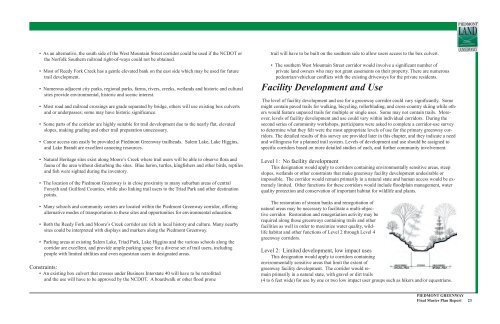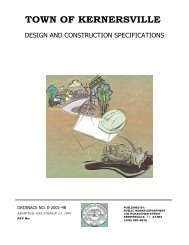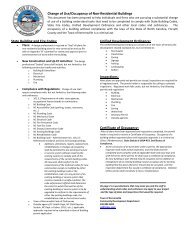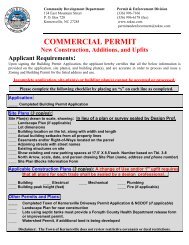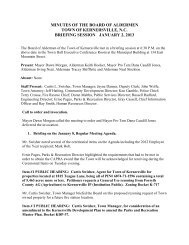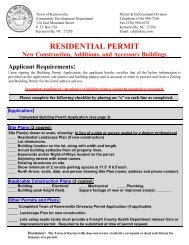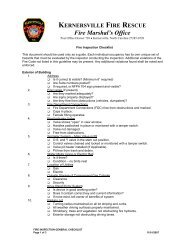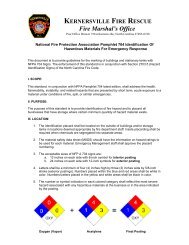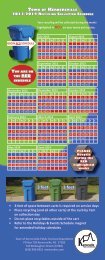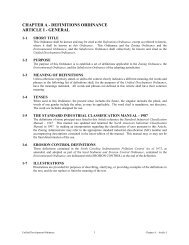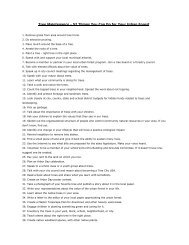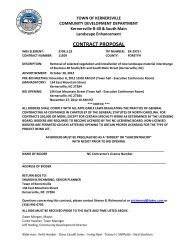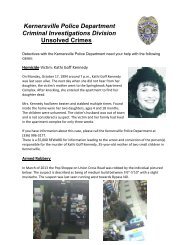Piedmont Greenway Master Plan - Town of Kernersville
Piedmont Greenway Master Plan - Town of Kernersville
Piedmont Greenway Master Plan - Town of Kernersville
- No tags were found...
You also want an ePaper? Increase the reach of your titles
YUMPU automatically turns print PDFs into web optimized ePapers that Google loves.
• As an alternative, the south side <strong>of</strong> the West Mountain Street corridor could be used if the NCDOT or<br />
the Norfolk Southern railroad right-<strong>of</strong>-ways could not be obtained.<br />
• Most <strong>of</strong> Reedy Fork Creek has a gentle elevated bank on the east side which may be used for future<br />
trail development.<br />
• Numerous adjacent city parks, regional parks, farms, rivers, creeks, wetlands and historic and cultural<br />
sites provide environmental, historic and scenic interest.<br />
• Most road and railroad crossings are grade separated by bridge, others will use existing box culverts<br />
and or underpasses; some may have historic significance.<br />
• Some parts <strong>of</strong> the corridor are highly suitable for trail development due to the nearly flat, elevated<br />
slopes, making grading and other trail preparation unnecessary.<br />
• Canoe access can easily be provided at <strong>Piedmont</strong> <strong>Greenway</strong> trailheads. Salem Lake, Lake Higgins,<br />
and Lake Brandt are excellent canoeing resources.<br />
• Natural Heritage sites exist along Moore’s Creek where trail users will be able to observe flora and<br />
fauna <strong>of</strong> the area without disturbing the sites. Blue heron, turtles, kingfishers and other birds, reptiles<br />
and fish were sighted during the inventory.<br />
• The location <strong>of</strong> the <strong>Piedmont</strong> <strong>Greenway</strong> is in close proximity to many suburban areas <strong>of</strong> central<br />
Forsyth and Guilford Counties, while also linking trail users to the Triad Park and other destination<br />
points.<br />
• Many schools and community centers are located within the <strong>Piedmont</strong> <strong>Greenway</strong> corridor, <strong>of</strong>fering<br />
alternative modes <strong>of</strong> transportation to these sites and opportunities for environmental education.<br />
• Both the Reedy Fork and Moore’s Creek corridor are rich in local history and culture. Many nearby<br />
sites could be interpreted with displays and markers along the <strong>Piedmont</strong> <strong>Greenway</strong>.<br />
• Parking areas at existing Salem Lake, Triad Park, Lake Higgins and the various schools along the<br />
corridor are excellent, and provide ample parking space for a diverse set <strong>of</strong> trail users, including<br />
people with limited abilities and even equestrian users in designated areas.<br />
Constraints:<br />
• An existing box culvert that crosses under Business Interstate 40 will have to be retr<strong>of</strong>itted<br />
and the use will have to be approved by the NCDOT. A boardwalk or other flood prone<br />
trail will have to be built on the southern side to allow users access to the box culvert.<br />
• The southern West Mountain Street corridor would involve a significant number <strong>of</strong><br />
private land owners who may not grant easements on their property. There are numerous<br />
pedestrian/vehicluar conflicts with the existing driveways for the private residents.<br />
Facility Development and Use<br />
The level <strong>of</strong> facility development and use for a greenway corridor could vary significantly. Some<br />
might contain paved trails for walking, bicycling, rollerblading, and cross-country skiing while others<br />
would feature unpaved trails for multiple or single uses. Some may not contain trails. Moreover,<br />
levels <strong>of</strong> facility development and use could vary within individual corridors. During the<br />
second series <strong>of</strong> community workshops, participants were asked to complete a corridor-use survey<br />
to determine what they felt were the most appropriate levels <strong>of</strong> use for the primary greenway corridors.<br />
The detailed results <strong>of</strong> this survey are provided later in this chapter, and they indicate a need<br />
and willingness for a planned trail system. Levels <strong>of</strong> development and use should be assigned to<br />
specific corridors based on more detailed studies <strong>of</strong> each, and further community involvement.<br />
Level 1: No facility development<br />
This designation would apply to corridors containing environmentally sensitive areas, steep<br />
slopes, wetlands or other constraints that make greenway facility development undesirable or<br />
impossible. The corridor would remain primarily in a natural state and human access would be extremely<br />
limited. Other functions for these corridors would include floodplain management, water<br />
quality protection and conservation <strong>of</strong> important habitat for wildlife and plants.<br />
The restoration <strong>of</strong> stream banks and renegotiation <strong>of</strong><br />
natural areas may be necessary to facilitate a multi-objective<br />
corridor. Restoration and renegotiation activity may be<br />
required along those greenways containing trails and other<br />
facilities as well in order to maximize water quality, wildlife<br />
habitat and other functions <strong>of</strong> Level 2 through Level 4<br />
greenway corridors.<br />
Level 2: Limited development, low impact uses<br />
This designation would apply to corridors containing<br />
environmentally sensitive areas that limit the extent <strong>of</strong><br />
greenway facility development. The corridor would remain<br />
primarily in a natural state, with gravel or dirt trails<br />
(4 to 6 feet wide) for use by one or two low impact user groups such as hikers and/or equestrians.<br />
PIEDMONT GREENWAY<br />
Final <strong>Master</strong> <strong>Plan</strong> Report 23


